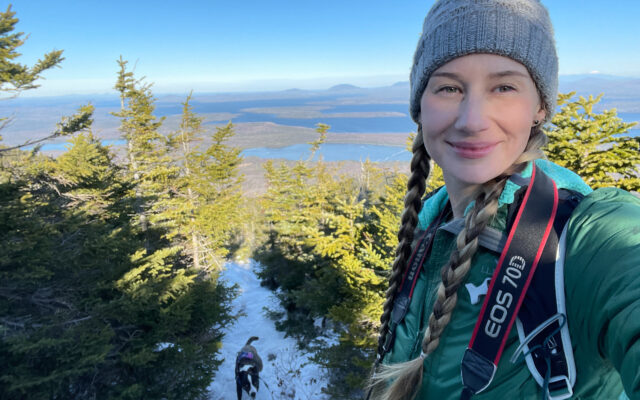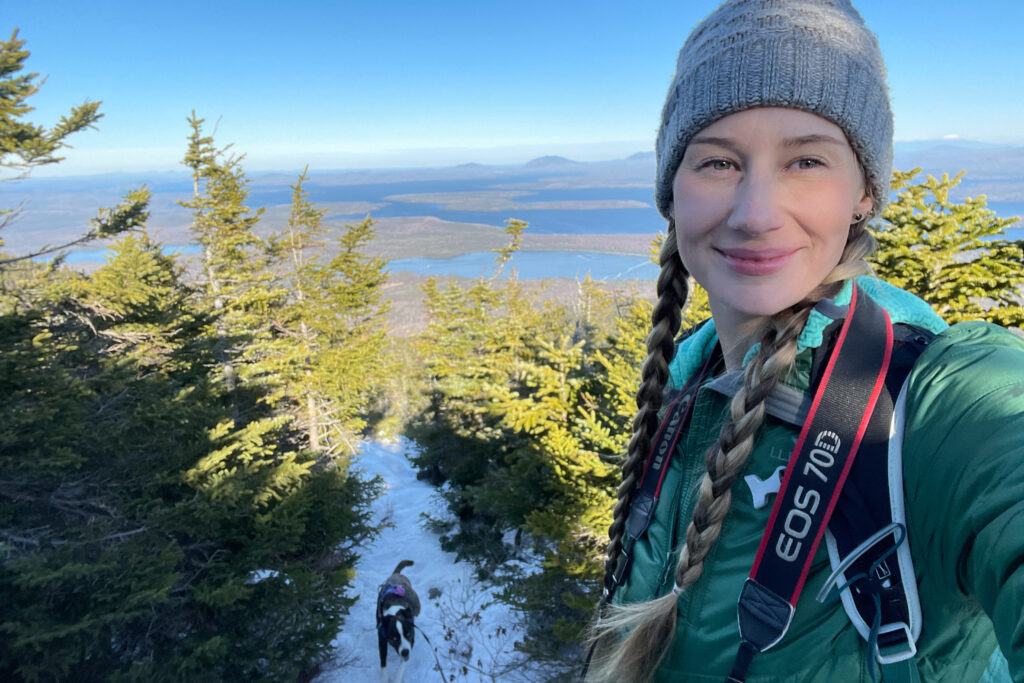
Solo hiking in winter is wonderful but can turn deadly
By Aislinn Sarnacki
With ice cleats strapped to my boots, I hiked up an icy, snowy mountain in the Moosehead Region a couple of days ago. My sole companion was my dog, Juno. And I understand that some people might not approve.
It is undoubtedly safer to hike with other people.
The dangers of hiking solo — especially in the winter — have been at the forefront of my mind due to the recent tragedy in the White Mountains of New Hampshire. Emily Sotelo, a 19-year-old student from Massachusetts, died in the mountains while hiking alone this November.

ICY HIKE — Aislinn Sarnacki takes a selfie while hiking Big Moose Mountain near Greenville. The trail was especially icy that day. Her dog, Juno, is sprinting up and down the trail behind her.
Officials said she became lost, wasn’t wearing warm enough clothing and likely died of exposure to freezing weather.
Every time I hear a story like this, it makes me pause and reassess the risks I take. It reminds me to go through all of the survival gear in my backpack. But most of all, it wrenches my heart to think of what she experienced out there in the cold.
Sotelo’s goal was to hike all of New Hampshire’s 4,000-foot peaks before her 20th birthday, and she was nearly there. Her parents told reporters that she was experienced in hiking during warm weather, just not in the winter.
Winter comes early to the White Mountains. It also comes early to Maine’s inland peaks. That’s why I traveled up to Moosehead this week, to see some snow.
My dog, Juno, a boxer-husky mix, loves snow. During the hike, if I took too long to clamber up a slope, she entertained herself by flopping onto her side and sliding over the icy crust, like an otter. My laughter echoed through the trees. We had a wonderful time that day.
In the mountains, it’s easy to forget all the ways that things can go wrong.
I’ve been hiking solo for years, during all seasons. It’s something I truly enjoy. The freedom. The quiet. The independence. The connection I feel with nature.
For me, hiking solo is worth the inherent danger. But, in order for anyone to make that decision for themselves, they need to first be aware of the risks. Only then can you try to minimize them.
As someone who’s constantly encouraging people to get outdoors and hike, I’m worried as we head into the coldest time of the year. I want people to be prepared for the biting wind, slippery ice and cold that creeps up on you during snack breaks.
In the winter, I view the cold as if it were an entity. The Cold. It’s not malicious or evil, but it’s ever-present and powerful. It burns in your lungs in the most refreshing way. And it can also seep into your bones if you aren’t careful.
When I pack for a winter hike, snowshoe trek or cross-country ski trip, I think of ways to combat The Cold. If I were to fall and break a leg, how could I stay warm until help arrived? Could I survive the night?
Extra clothing, heat packs, an emergency bivvy and a firestarter kit all go into my backpack. Other basic survival gear that I carry include a whistle, multi-tool, compass, map and snacks.
The Appalachian Mountain Club provides a great online list of essential gear for winter hiking that I reference from time to time.
But perhaps the most important thing you can do to improve your safety outdoors is communicate with people about your plans. Accidents happen. And if you need saving, time is of the essence, especially in the winter.
I carry a Garmin inReach, a GPS device that tracks my movements and can be used to message for help, even when there is no cell phone reception. In addition, I tell someone where I’m going and when to expect me to return.
If you’re new to winter hiking, I suggest that you start small. Visit a local park or preserve. Hike with others. Hire a guide. Become comfortable with your gear. Allow yourself time to discover that your ice cleats pop off your boots and your mittens aren’t warm enough.
Know that winter hiking can be even more dangerous when there isn’t much snow. That’s when ice reigns supreme. And ice can be scary.
I also want you to know that if you sweat in cotton clothing, the material holds onto that moisture and can cool your body temperature rapidly. So it’s best to wear synthetics or wool.
I could go on and on with winter hiking tips. (I hope you add some of your own in the comments section.) But I think it’s important to understand that ensuring your safety in the outdoors takes time, effort and experience. Proceed with caution. But proceed.
Whatever you do, don’t lock yourself away indoors.
The winter wilderness is an enchanting place, where sunlight sparkles and chickadees sing. In the Moosehead Region, I found a tiny bird’s nest on the ground, dusted with snow. Juno flushed a ruffed grouse. And from the top of the mountain, I could see that some bodies of water had frozen into silver, while others remained open and reflected the rich blue of the cloudless sky. I wouldn’t have wanted to miss that.